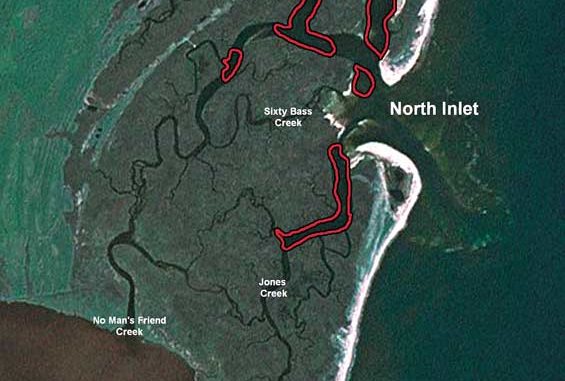
North Inlet’s backwaters hold a treasure trove of flatfish. Use these techniques to put them in the boat.
Located at the southern tip of the Grand Strand, North Inlet is a sportsman’s paradise, loaded with crabs, small fish, shrimp, and the inshore angler’s trifecta — flounder, redfish, and trout.
As the water warms significantly throughout April and into May, flounder abandon their winter ocean hangouts and glide back through the narrow channel of North Inlet, taking position in nearby creeks to ambush the first available prey. They show little selectivity as they move back, creating optimal conditions for the avid flattie fanatic.
Out of all inshore species, flounder undeniable express the notion, “survival of the fittest.” They are truly remarkable, having both eyes on the same side of their body, no air bladder and the ability to change their coloration to match the surroundings. These adaptations offer flounder an effective way to avoid predators and the ability to efficiently ambush passing baitfish while laying motionless and undetected along the bottom. Unlike many other species, flounder can live in just a few inches of water.
North Inlet’s extensive network of marsh, tidal creeks, and saltwater influence is nearly perfect for sustaining a wealth of sea life, and with good reason. With little resemblance to neighboring Myrtle Beach, the North Inlet jewel is a pristine, untouched wilderness harboring a species-rich environment and healthy gamefish populations.
The inlet floods the adjacent marshes with rich saltwater, overpowering the freshwater that trickles in from the hills and sloughs of the Waccamaw Neck, its limited watershed. The shallow marsh system blocks freshwater intrusion and spillover from Winyah Bay and its swollen, deep-water channel formed from the convergence of five rivers. The shallow marsh between Winyah Bay and North Inlet is only passable through a network of small tidal creeks bustling with navigational hazards, which contribute to its somewhat limited access and super-protected fisheries.
But that’s nothing more than a walk in the park for Gene Dickson of Delta Guide Service (843-546-3645), a veteran of 25 years of guiding fishermen whose inshore experience is unmatched within the region. Among his many specialties, flounder are in trouble when his Hewes Redfisher shows up in the mouth of a oyster-laden creek off of North Inlet.
“As the water starts to warm in April and May, flounder move back inshore, but the bigger fish will arrive by mid-May and early June and stay in until sometime late in the fall,” Dickson said.
Flounder move into the estuary on a hunt for food. They are found in a wide range of depths, from near the mouth of the inlet to just a few inches of water in the back of tidal creeks. Although many anglers dredge the smooth bottoms of creek mouths, including Jones Creek, Town Creek, and Debordieu Creek, Dickson slides further up the creeks in his flats boat and has great success in the shallows away from the traditional flounder fisherman.
“The fish are far up into the creeks around shell beds, ditch mouths, grass beds and around any kind of structure,” Dickson said. “Of course, where bait congregates, so do the predators.”
Typically, Dickson uses a modified version of the traditional flounder rig. Flounder are sensitive to unnatural sensations and often release minnows they’ve grabbed, with the angler sometimes completely unaware.
“With the traditional flounder rig, the weight is between the hook and the fisherman, so the bite will be harder to detect. With our modified rig, the fisherman is attached to the hook and the sinker has very little effect on feeling the bite.”
Dickson cuts a 28-inch segment of 20-pound Berkley Big Game, slides on a 30-pound black barrel swivel and ties it using an overhand knot about one-third of the way down the line. To the short end, he ties a bank sinker and a 3/0 or 4/0 Kahle hook on the long end of the leader. Finally, he ties the barrel-swivel loop to the terminal end of the line attached to the reel.
The upper reaches of creeks and even smaller creek mouths in the North Inlet area are littered with sharp objects and other tackle busters. Flounder are ambush feeders and will always be close to the available forage. Small shrimp and minnows toddle around in the oyster mounds and grass flats, foraging and evading being eaten themselves.
At waters flow into the marsh on the rising tide, huge areas with a rich forage base are submerged, offering food and cover for baitfish — but only for a short time. When the tide falls and leaves on a tenth of the water remaining, small holes at the mouths of creeks and deeper, wnding channels within oyster havens receive the hordes of minnows and shrimp.
These pinch points offer flounder and other predators ideal conditions for easy meals. Dickson concentrates on those areas, casting to those holes as the water falls out of the flats. However, the oyster-encrusted holes can contribute to tough fishing for anglers using standard rigs. Dickson relies on floats to keep his baits in the strike zone and out of the oysters, preferring cigar-shaped floats on heavy, 30-pound test leaders with a split shot attached about six inches above a 3/0 or 4/0 Kahle hook.
“Set the depth to where the bait is about six inches above the bottom. Then just cast or pitch the rig around oyster points, pilings, a shell mound, a grassy point, or an abandoned crab trap,” he said.
As the waters leave the shallows, the dark, exposed mud flats warm quickly, warming the water when the tide starts flooding again. Small baitfish and developing shrimp slide into these areas, congregating as the water continues to flow onto the flats. Generally, these creatures follow the progression of the tide deeper into the protected cover. Unfortunately for the shrimp and small baitfish, a flounder’s pancake shape allows it to mingle unnoticed in these same areas until it is too late.
Die hard fisherman Jay Nelson of Georgetown first notices flounder showing up mixed with the redfish he targets in the backs of remote creeks beginning in April and May. Nelson fishes about 150 days a year in the area, and even his ruthless affliction for redfish can’t keep him from targeting flounder on many occasions.
“In the spring, I look for the warmest water at the back of the creeks where the sun has had a chance to warm up the shallow water,” he said.
In the spring and early summer, Nelson poles into these shallow creeks on the lower end of falling tides and during the first few hours of the rising tide. He slips around bends and stops on occasion, fan-casting to oyster bars, stumps, and pilings. He uses a Cajun anchor — a “shallow-water anchor” — to stop his boat briefly to fish a set of oysters. Widely used by locals in the Georgetown area, the Cajun anchor is a stainless steel rod with a ring on the upper end through which it is tied to boat with a line. Nelson’s pole is applied manually, unlike the Power Pole, which is deployed by the touch of a button. Both are popular in the shallows, where stealth and convenience are at a premium. Generally, flounder will eat when baits are presented effectively, and a few casts at each spot will quickly tell if a spot is holding anything.
Nelson and Dickson rely mostly on live bait — finger mullet and mud minnows — attached to flounder rigs, but artificial lures often entice strikes from flounder. Dickson lands numerous fish each year on floating Rat-L-Traps and Cotton Cordell’s “Big O” crankbaits in chartreuse, shallow-diving models. Nelson uses paddletail or curlytail grubs fished on quarter-ounce jigheads, soft-plastic jerkbaits, artificial shrimp, and spinnerbaits slow rolled along the bottom. While live bait is generally the first choice, artificial lures catch many flounder every year.

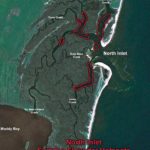
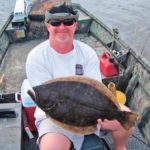
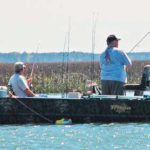
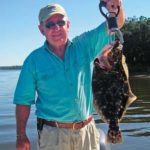
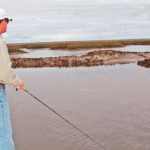
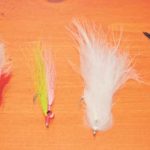



Be the first to comment